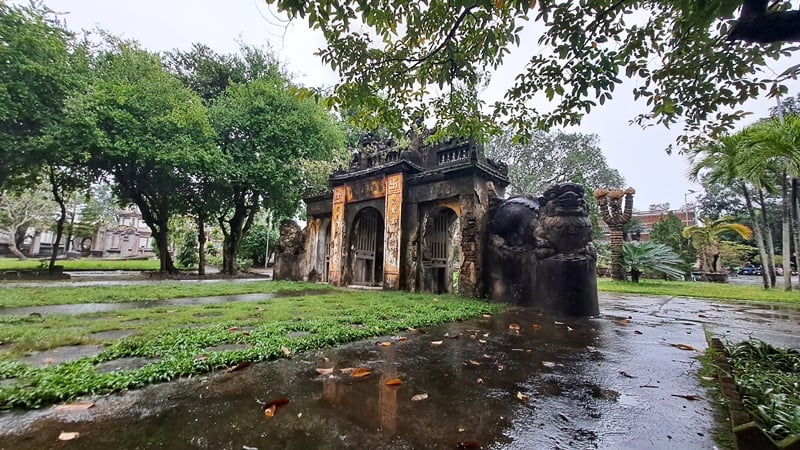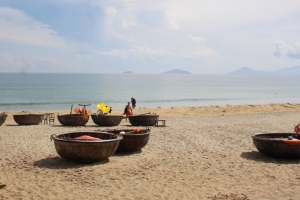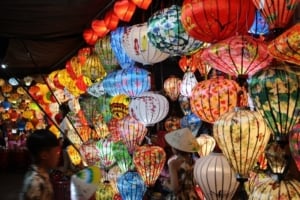Commonly pagodas are places to worship Buddha. But, people in Hoi An City call any place sacred and relevant to the spiritual life of humans a pagoda. For that reason, the locals have mistakenly thought of many actual holy shrines and temples as pagodas.
These sacred places and temples in this city have lived with the locals for a long time, indicating that the people here are kind-hearted and inclined to the good.
Today, we will explore the popular pagodas and temples in this city.
The Popular Pagodas in Hoi An
Many pagodas in Hoi An become holy places for the locals to pay for good things. With the influence of Cham culture (focusing on the female god), a few pagodas worship the lady god, such as Chua Quan Am ( Kwan Yin Pagoda at 107 Nguyen Hue Street). Besides, another feature of most pagodas in Hoi An is the tranquility, not the glorious decoration or not having huge buildings as in other places.
Now please explore these pagodas!
The pagoda of Kwan Yin (107 Nguyen Hue St)
Built in 1628, this pagoda venerates Kwan Yin and some other Buddha. It is the only old pagoda remaining in the old quarter of Hoi An. It has beautiful architecture and landscapes. Several wood sculpture works are preserved here and reflect the skill of local craftsmen. It is believed that Chinese and Japanese traders offered these sculptures to the pagoda.
Chuc Thanh Pagoda (Tan Hoa, Tan An)
This is the oldest pagoda in Hoi An. Legends say the pagoda was built by settlers from the North in 1454 but the present structure was upgraded by Zen Monk Minh Hai in the 17th and 18th centuries. It is also the ancestral communal house of the Lam Te – Chuc Thanh Hermitage originating from the South.
Several old vestiges still exist: brass bells, musical stones, and wooden drums that date back about two centuries ago. The anniversary of its founder, Zen Monk Minh Hai, is celebrated each year on the 6th and 7th of the faithful and pilgrims from southern provinces.
To access the pagoda, one must turn right from Nguyen Duy Hieu St. at Monument Square and take the 200m dirt road.
Phuoc Lam Pagoda (Village No.2A, Cam Ha)
A Buddhist monk, Minh Giac, built it in the mid-18th century. There is a story about this pagoda: A young man named An Thiem became a novice at the pagoda when he was eight. When he was 18, the King ordered that all young men must enlist in the army to suppress rebellion. An Thiem volunteered for the service on behalf of his older brother. He fought well and was promoted as a general. After that war, he returned to the pagoda to continue his religious life. But he felt guilty for all the atrocities committed during the war so he volunteered to clean the market in Hoi An. After 20 years of penitence, he returned to the pagoda and became the presiding monk of Phuoc Lam Pagoda.
There are two ways leading to Phuoc Lam Pagoda: one way is going past the Chuc Thanh Pagoda about 350m; At Monument Square, you can see the tombs of 13 Chinese heroes of the Second World War: they fought the Japanese military imperialists but were caught and massacred. One of these Chinese heroes was Musician La Hoi who had composed a famous pop song: Xuan va Tuoi Tr (Spring and Youth). The other way is from Thai Phien St and by the canal bank.
Van Duc Pagoda (Cam Ha Ward, Hoi An)
Built in the late 17th century by a Zen Buddhist the pagoda was frequented by both rich and poor inhabitants of the area. Lying on the Co Co River (stork’s neck river) that links Da Nang and Hoi An, many businessmen often stopped here to worship and pray for luck in their business dealings. The pagoda keeps many old artifacts such as old books and statues related to the history of Hoi An and the development of Buddhism in the area.
Vien Giac pagoda (Cam Ly Tu, 34 Huynh Thuc Khang St.)
This pagoda was built from the combination of a Chinese pagoda at Tu Le, Cam Pho, and a Vietnamese pagoda, the Cam Ly pagoda at Xuyen Trung, Cam Nam. It is a mixture of two modes of worshipping Buddha, one Chinese and one Vietnamese. Relics at the pagoda show the interrelationships of the two cultures. Each year, the pagoda solemnly celebrates Buddha’s birthday (14th day of the 4th lunar month) and Mother’s Soul Day (14-15 of the 7th lunar month).
Hai Tang Pagoda (Bai Lang, Cham Island, Hoi An)
The pagoda lies at the foot of a mountain west of Bai Lang commune, Cham Island, Hoi An, Quang Nam. The scripture on a stele says Hai Tang Pagoda was built in 1758. It was moved to the present location in 1848 following the havoc caused by storms. The pagoda has a big brass bell molded in 1770. Legends say marine traders often dropped by to pray and supply the pagoda with fresh water. It has nice architecture amid a beautiful landscape with Cham Island in the background.
Kim Buu Pagoda (Village No 3, Cam Kim)
This pagoda is situated by the Thu Bon River on Cam Kim Island. It can be accessed either by boat (the ferry is located in front of the pagoda) or by road, about one kilometer from the city. This pagoda belongs to the Kim Bong village and is noted for its woodwork.
The structure is shaped after the Chinese character “Nhat” (one) with three compartments and two sheds. Two bell towers with the character “Phuc” (happiness) inscribed rise above the two sheds. On the rooftop is a lotus-flower structure. Since the pagoda has no presiding monk, the village has to assign someone to take care of the pagoda. It is also an object of research on the Buddhist faith.
The Famous Old Temples in Hoi An Ancient City
There still exist 43 temples in Hoi An venerating gods, saints, sages, and the souls of heroes, and benefactors of the people and community. The size of the temples depends on the fame of the venerated person and the economic conditions of the community. In general, they are valuable collections of folkloric arts and cultural works of the populace.
Here are the famous old temples in Hoi An Ancient City to visit.
Quan Cong Temple (24 Tran Phu St.)
The temple was built in 1653 to venerate Quan Cong, one of the three sworn-in brothers in the famous novel “Three Nations” representing Loyalty, Credibility, Chastity, and Charity, the four most prized qualities. Quan Cong Temple, also called Ong Temple, was been restored several times, in 1753, 1783, 1827, 1864, 1904, and 1966. Situated in front of the main market in Hoi An, it has been a place of worship for the residents. Many traders frequent this temple to pray for their business. During the war, people came to pray for safety.
Van Thanh Temple (20 Phan Chau Trinh St.)
Built in 1867 by the Chinese Minh Huong who had arrived in the mid-17th century and was naturalized Vietnamese. The temple venerates Confucius, Confucian sages, and academic laureates from the region. It was overhauled in 1911. Rumors say any student praying at the temple will successfully pass their examinations. People often prayed here to ask for children and it is said that those children born to those who prayed were all intelligent and excellent in their studies.
Lord Cam Nam’s Mausoleum
Past the Cam Nam Bride about one km is the mausoleum which is a complex of five structures built by the fishermen of Van Xuan and inhabitants of Ha Trung: Lang Ong (Lord’s mausoleum), the Tho Than (Local Spirit), Ngu Hanh Temple, Temple of Ghosts, and the temple of cargo boats. These structures were first built in the 18th century at various locations but fear of landslides has forced people to group them at the present site.
Each structure is dedicated to one personage: the Tho Than Temple is dedicated to the spirit that governs the area; the Ngu Hanh is to all gods governing the universe; the Ghost Temple is to the souls of war heroes and victims; the Lord’s mausoleum, to benefactor whale, the god of waterways; the Cargo Boat Temple, to the goddess that governs the Water World.
Festivals are organized at the complex each year, on the 10th day of the second lunar month and the 15th day of the seventh lunar month.
Temple of the Dead (76/9A Tran Phu St.)
Since Hoi An is located in the lower basin of the Thu Bon River at a junction of many rivulets, floods from the river took heavy tolls on human lives every year and the corpses floated along the river down to Hoi An. They were picked up by the city residents and buried in the public cemeteries. In addition, the war killed many soldiers from both sides fighting around Hoi An. Its inhabitants have built a temple dedicated to all those souls. There is a board hung inside the temple inscribing a verse: “In dedication to the thousands of unknown ghosts.”
Nam Dieu Forebear’s Temple (Block 7, Thanh Ha)
This is a cluster of small temples venerating various gods and spirits. The most important of them is the temple dedicated to the founder of ceramics and brickmaking in town. At the start of the lunar year, folks hold festivals to pray for their founder and other gods and spirits to sponsor their businesses and grant them luck.
Tips to visit these pagodas and temples
As the same rules to visit most temples and pagodas in Vietnam, you need to wear elegant clothes covering your shoulders and knees.
Most pagodas are free to visit, but some temples in the ancient town of Hoi An need tickets to come into. The ticket is sold at the beginning of the streets entering the old town area. Please check the ticket price here.
The time to visit these places is good from 7:00 am – 5:00 pm.
If you want to choose the top pagoda in Hoi An to visit, Vietnamdrive recommends you come to Chuc Thanh Pagoda. And, the top temple to explore in the old town is Ong Temple. Please note that all temples in the town center are very small.
Most temples and pagodas often offer incense for visitors to pray. If you do, please burn one or three sticks. These numbers are common Yang ones, showing the starting and developing features.
One of the ways you can donate or support the temple is to buy a big circle of incense to burn. The money will help the pagoda to maintain it, or the owner can use it to give the poor.
Taking pictures is not missed because most of the temples and pagodas have beautiful architecture and skillful wood carving to decorate.




